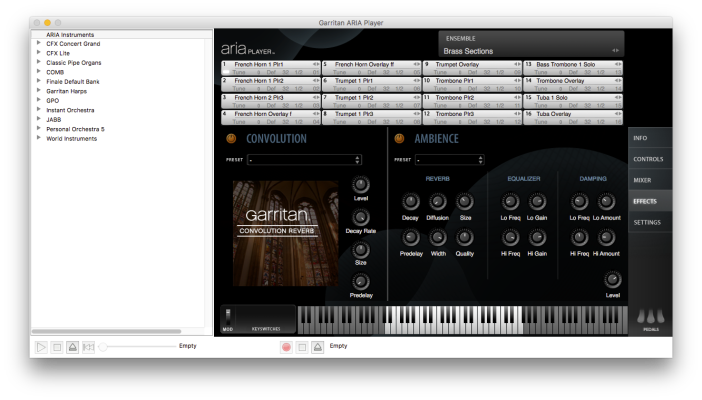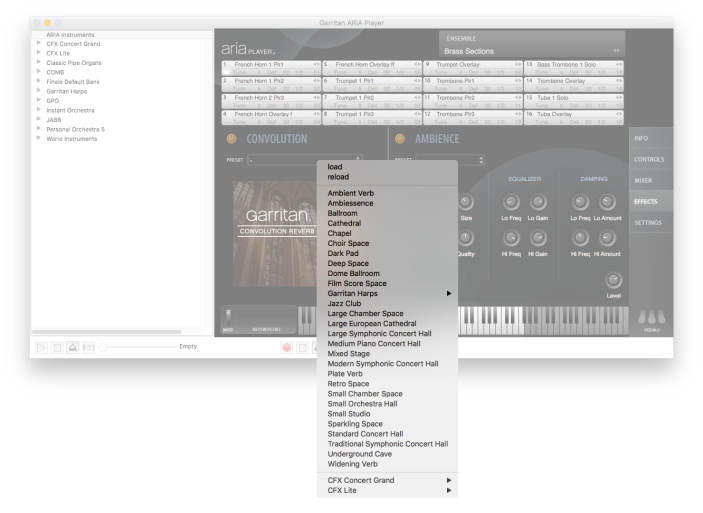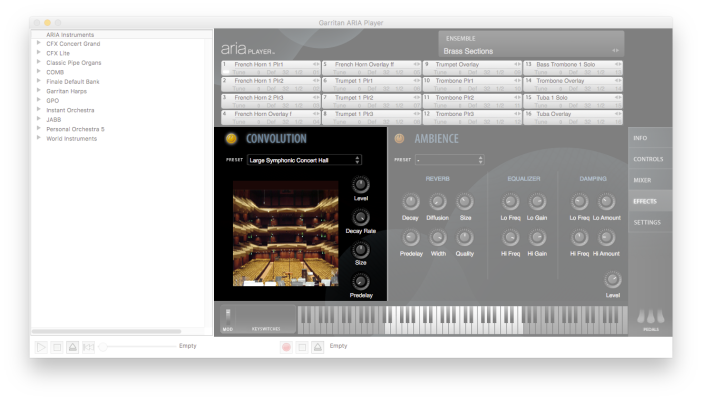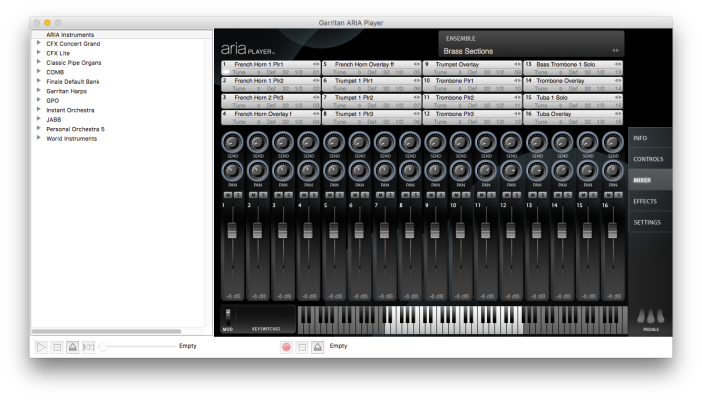Convolution reverb

What it does
The ARIA Player includes a convolution engine for high-quality sampled reverb. Just as a Garritan sample libraryA piece of software consisting of a collection of recorded instrument sounds. Sample libraries can be used to play back existing MIDI sequences or to act as a live virtual instrument. contains sounds of actual musical instruments, the Convolution reverb was created by sampling the reverberationThe audio phenomenon that occurs when a sound is reflected and absorbed by surfaces in a physical space. Reverberation effects are used to add depth and realism to audio recordings. Commonly abbreviated as reverb. in an actual acoustic space, such as a concert hall or cathedral. Convolution reverb uses impulse responses, which are the recorded reverberations of a space when an impulse sound is played within that space. The impulse responses are used to accurately reproduce the character of the space, including the imperfections and nuances that give the space its unique identity.
When you're using convolution reverb, you're effectively placing your instruments in the sampled space. Lifelike reverb is an important part of any project, as it provides continuity of perception and authenticity to the listener. The ARIA Player includes ten impulse responses (in ARIAP format); certain Garritan sample libraries include additional responses.
- Chapel. Sampled reverb from a famous chapel in Cambridge, Massachusetts, USA.
- Dark Pad. Algorithmic reverb based on a simulated impulse response.
- Deep Space. Algorithmic reverb based on a simulated impulse response.
- Film Score Space. Sampled reverb from a well-known film scoring space in Seattle, Washington, USA that has been used for many popular movies.
- Jazz Club. Sampled reverb from a legendary Greenwich Village jazz club in New York, New York, USA.
- Large European Cathedral. Sampled reverb from a large cathedral in the Czech Republic.
- Large Symphonic Concert Hall. Sampled reverb from a well-known large concert hall located in Seattle.
- Medium Piano Concert Hall. Sampled reverb from one of the best piano halls located in upstate New York.
- Modern Symphonic Concert Hall. Sampled reverb from a modern state-of- the-art concert hall located in Vancouver, British Columbia, Canada.
- Retro Space. Algorithmic reverb based on a simulated impulse response.
- Small Chamber Space. Sampled reverb from a small chamber recording space in Boston, Massachusetts, USA.
- Small Orchestra Hall. Sampled reverb from a small concert hall located in Brno, Czech Republic.
- Traditional Symphonic Concert Hall. Sampled reverb from the Dvorak Hall (the Rudolphium), a large traditional concert hall in Prague, Czech Republic.
- Underground Cave. Sampled reverb from an underground cave located in the Czech Republic.
- Algorithmic Spaces. These impulse responses originated from a hardware reverb unit and are synthesized rather than recordings of physical locations.
- Ambient Verb. A medium sized room.
- Ambiessence. A large, spacious room.
- Cathedral. A typical cathedral.
- Chamber Space. A space for a mid-size ensemble.
- Choir Space. A performing space for a choir.
- Concert Hall. A typical concert hall in a variety of sizes.
- Dome Ballroom. A physically round ballroom space.
- Mixed Stage. A combination of perspectives from the stage and from within a performance hall.
- Plate Verb. A standard plate reverb.
- Small Studio. A small to medium room in a professional recording studio.
- Sparkling Space. A mid-sized space with bright treble.
- Versatile Ballroom. A typical ballroom.
- Widening Verb. A preset that expands the stereo sound rather than adding perceived reverberation.
For individual instrument patchesA particular instrument sound, often containing multiple samples. The term is borrowed from physical synthesizers in which cables were used to connect sound modules. Also referred to as program. and most ensemble presets, Convolution reverb is turned off by default; to activate it, you must click the on/off switch ( /
/ ) located in the Effects view. For ensemble presets in the Garritan Classic Pipe Organs and Garritan Harps libraries, Convolution is on by default and Ambience off. It may not be necessary to use Convolution reverb when using Ambience or vice versa. Additionally, there are some situations where you may want to use both Ambience and Convolution reverb to exaggerate a certain space or element.
) located in the Effects view. For ensemble presets in the Garritan Classic Pipe Organs and Garritan Harps libraries, Convolution is on by default and Ambience off. It may not be necessary to use Convolution reverb when using Ambience or vice versa. Additionally, there are some situations where you may want to use both Ambience and Convolution reverb to exaggerate a certain space or element.
Turn reverb on or off so that you can easily hear loaded instruments with either no reverb or with the current reverb settings.
- Click the Effects button. The Effects view appears.
- Under Convolution, click the power button to turn reverb on
 or off
or off  .
.This button works exactly like the bypass option commonly available to audio plug-ins.

- Click the Effects button. The Effects view appears.
- Turn Convolution reverb on
 .
. - Click the Preset menu and choose an impulse response from the drop-down menu that appears.
- AdjustClick and drag the knob up or right to increase and down or left to decrease. the Level, Decay Rate, Size, and Predelay knobs until you achieve the desired reverb sound.
- The Level knob operates like a return level, determining the volume of the reverb.
- The Decay Rate knob controls the time it takes for the reverb reflections to fade away into silence.
- The Size knob controls the size of the room. Note that long reverb time (decay) and small room size do not mix well. For natural sounds, the room size should correspond with the length of the reverb time.
- The Predelay knob controls the amount of time between the impulse and the first of the reverb reflections, defining the perception of the size of the space.
- Click the Mixer button. The Mixer view appears.
- AdjustClick and drag the knob up or right to increase and down or left to decrease. the Send knob for each instrument to which you want to apply Convolution reverb.
This knob functions as your wet/dry control, determining how much of the instrument signal to send to the reverb.


Selecting a preset loads an impulse response, and a picture representing the space appears.
You can also choose to load an external impulse response by clicking load aria preset and navigating to the location of the ARIAP file.


If after loading a preset and adjusting the settings you decide that you prefer the original sound of the preset, reload the preset to restore its original settings.
- Click the Effects button. The Effects view appears.
- Click the Preset menu and choose reload.
- Audition the sound using the onscreen keyboard or your connected MIDI controllerAny device, such as a piano keyboard or wind instrument, that transmits performance information as MIDI data. The ARIA Player can use these devices for live playback and control..
Note that the only visual indication that the impulse response has been reloaded is that the control knobs have been reset to their default values.



